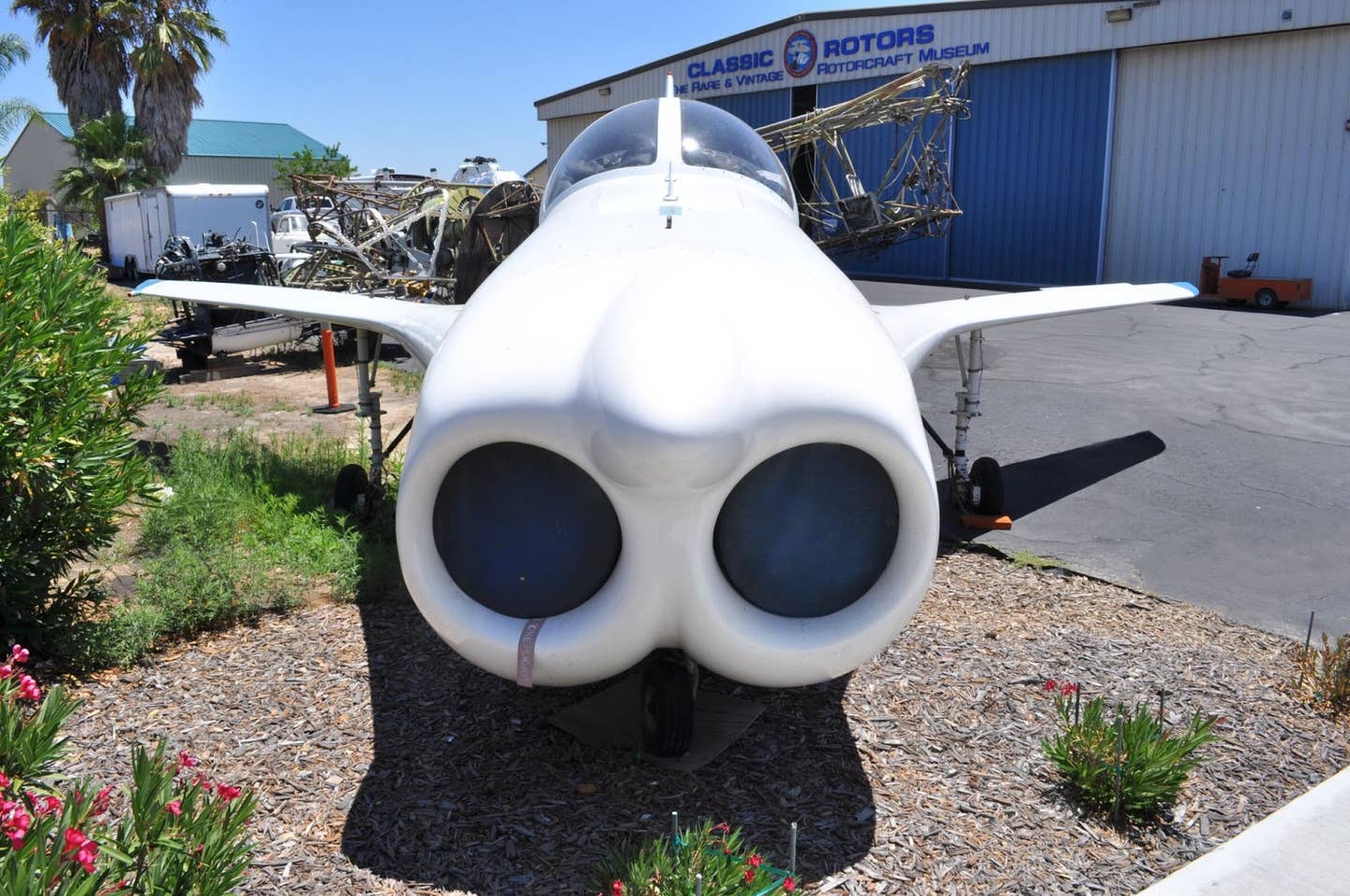Unique Aircraft: The duPont DP-2, a Futuristic VTOL Boondoggle
Resembling a composite, modernized version of the 1950s-era Bell X-14, the duPont Aerospace DP-2 failed to deliver on lofty promises.

Resembling a composite, modernized version of the 1950s-era Bell X-14, the duPont Aerospace DP-1, the prototype for the DP-2 concept, is now displayed at the Classic Rotors Museum in Ramona, California. [Credit: Jason McDowell]
Since the dawn of the jet age, the aviation industry has pursued the holy grail of vertical takeoff and landing (VTOL) capability—an aircraft that can take off and land vertically, but also cruise at jet speeds. A few fighter/attack aircraft like the Harrier, Yak-38, and F-35B—as well as a number of similar experimental jets—have successfully achieved the goal. In the 1960s, Dornier even built two experimental VTOL cargo jets that successfully flew.
Beyond heavily-funded government/military programs, however, VTOL jets have eluded civil aviation. But as demonstrated by the duPont Aerospace DP-1, it hasn’t been for a lack of trying.
The duPont story began in the early 1980s, when founder and president Anthony "Tony" duPont developed a concept for a jet-powered VTOL aircraft called the DP-2 that could serve as a military transport as well as a civilian airliner. With a projected maximum weight of 53,000 pounds, the conceptual DP-2 was proposed to transport 50 passengers at speeds of up to 0.95 Mach and 45,000 feet. It was also touted to provide range sufficient for transcontinental travel in the U.S.
DuPont approached the U.S. Navy, Air Force, and Marine Corps with proposals for military versions of the DP-2 and, one by one, each branch declined to pursue development of the aircraft, citing numerous technical faults. The Defense Advanced Research Projects Agency (DARPA) followed suit when it gathered a panel of experts who similarly expressed doubt that the concept could be brought to fruition.
Undeterred, duPont continued development in the form of the 53-percent-scale DP-1 and ultimately built one example, shown here. Constructed from composite materials and powered by two Pratt & Whitney 535A engines—as found in the Cessna Citation Encore—it took on a general configuration similar to that of the 1950s-era Bell X-14.
In this configuration, the engines are placed ahead of the center of gravity to permit the thrust to be vectored downward near or at the center of gravity. Laterally, they are placed as close to the centerline as possible to minimize the complication of asymmetric thrust in the event of an engine failure. Lacking traditional exhaust nozzles, the aft fuselage was unoccupied and could be made available for cargo ramps in future military variants.
Control was provided by a system of carbon fiber vanes mounted in the belly of the fuselage. These vanes were linked to the flight controls and provided control by ducting the engine exhaust in the desired direction. Compared with existing VTOL control systems that routed bleed air through the airframe and out of the tailcone and wingtips, the DP-1’s system was comparatively light and simple.
Tethered ground testing began in 2002. Shortly thereafter, the Office of Naval Research issued a new requirement that all hover testing would have to be accomplished autonomously without a pilot in the cockpit. DuPont estimated that this requirement would cause the time and cost of the program to increase by a factor of three, but in 2003, he achieved the requirement by establishing a tethered, autonomous hover.
A series of tethered hovers would be the extent of the DP-1’s flight experience.
By 2007, the DP-1 had achieved sustained, tethered hovers lasting 45 seconds and meeting the Navy’s requirements for a controlled hover. Unfortunately, the House Committee later held a hearing on the progress of the program and opted to defund it. The testimony was scathing, with critics stating, among other criticisms, “Congress appears to have permitted the DP-2 program to become a hobby, not a serious research project, and squandered more than $63 million of taxpayers’ money.”
In the end, the DP-1 would never achieve untethered flight. Nor would the team conduct high-speed taxi testing or forward flight without the use of the aircraft’s vertical lift capability. Today, it is on display at the Classic Rotors Museum in Ramona, California. The company’s website is similarly mothballed and on display at the museum, still providing marketing videos of the proposed DP-2.

Sign-up for newsletters & special offers!
Get the latest FLYING stories & special offers delivered directly to your inbox






